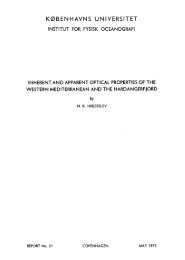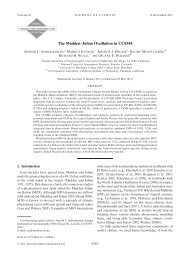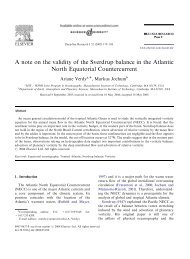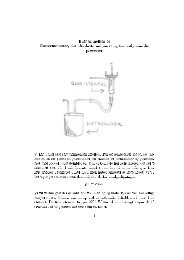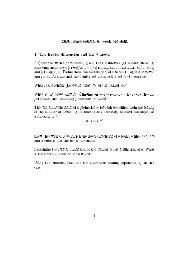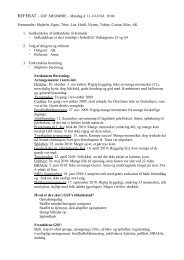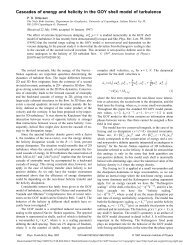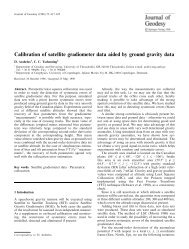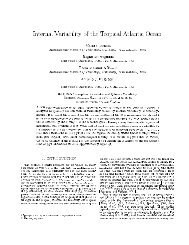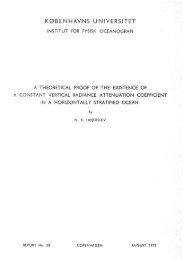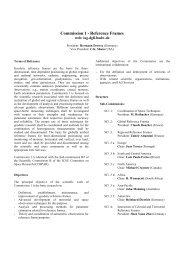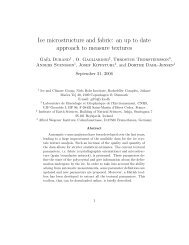Reduced point mass or multipole base functions. - Niels Bohr Institutet
Reduced point mass or multipole base functions. - Niels Bohr Institutet
Reduced point mass or multipole base functions. - Niels Bohr Institutet
You also want an ePaper? Increase the reach of your titles
YUMPU automatically turns print PDFs into web optimized ePapers that Google loves.
<strong>Reduced</strong> <strong>point</strong> <strong>mass</strong> <strong>or</strong> <strong>multipole</strong> <strong>base</strong> <strong>functions</strong>.C.C.Tscherning, M.Veicherts, 1 M.Herceg 2 ,1 <strong>Niels</strong> <strong>Bohr</strong> Institute, University of Copenhagen, Denmark.2 DTU Space, Denmark.Juliane Maries Vej 30, DK 2100 Copenhagen Oe, Denmark.Abstract: Point-<strong>mass</strong> <strong>functions</strong> <strong>or</strong> <strong>multipole</strong> <strong>base</strong>-<strong>functions</strong> are harmonic<strong>functions</strong>, which may be used to represent the (anomalous) gravity potential (T)globally <strong>or</strong> locally. The <strong>functions</strong> may be expressed by closed expressions <strong>or</strong> assums of Legendre series. In both cases at least the two first terms must be removedsince they are not present in T. F<strong>or</strong> local applications the effect of a global gravitymodel is generally removed (and later rest<strong>or</strong>ed). Then m<strong>or</strong>e terms need to beremoved <strong>or</strong> substituted by terms similar to err<strong>or</strong>-degree variances. We have donesome calculations to illustrate the effect of reducing the <strong>point</strong> <strong>mass</strong> <strong>or</strong> <strong>multipole</strong><strong>functions</strong>, i.e. showing how the first zero-crossing as a function of sphericaldistance comes closer to zero when m<strong>or</strong>e terms are removed.1. Introduction.Linear combinations of <strong>point</strong> <strong>mass</strong> <strong>functions</strong> <strong>or</strong> <strong>mass</strong> <strong>multipole</strong>s have been usedf<strong>or</strong> the representation of the global (W) <strong>or</strong> regional anomalous gravity potential, T,see e.g. Balmino (1974), Hauck and Lelgemann (1985), Vermeer (1982, 1989,1990,1992,1993), Marchenko et al., (2001), Ballani et al. (1993), Wu (1984).The anomalous potential T, is equal to the difference between W and a globalgravity field model like EGM96 (Lemoine et al., 1998), ie. it is a harmonicfunction.F<strong>or</strong> a <strong>point</strong> <strong>mass</strong> <strong>base</strong> function we have f<strong>or</strong> an approximation to T:T = Ii=1GM i /l i(1)
where G is the gravitational constant, M i is the <strong>mass</strong>, I the number of <strong>point</strong> <strong>mass</strong>esand l i is the distance from the <strong>mass</strong> located at the <strong>point</strong> Q i to the <strong>point</strong> ofevaluation, P, see Fig. 1. The distance from the <strong>or</strong>igin to P and Q i is denoted r P , r Qi ,respectively and the first will always be larger than the other. The angle (sphericaldistance) between the vect<strong>or</strong>s to P and Q i is denoted ψ.PQFig. 1.We now drop the subscript on Q. The distance l, from P to Q is then l =r 2 P + r 2 Q − 2r P r Q cos (ψ). F<strong>or</strong> the inverse distance we have∞1l = 1 r iQ Pr P r i (cosψ)Pi=0(2)where P i are the Legendre polynomials. Multipole-<strong>functions</strong> are derive from theinverse distance function by integration <strong>or</strong> differentiation (compare Tscherning andRapp (1974)), and will be denoted f.MT(P) = α i f i (P)i=1(3)MThe estimate T is determined so that ∑ i=1({L i T} − obs i ) 2 = min, where M is thenumber of observations and L i are the linear functionals associated with theobservations. In the computations described below we only consider heightanomalies (geoid heights), gravity disturbances and second-<strong>or</strong>der radial derivatives.We intend to show that in <strong>or</strong>der to make the <strong>functions</strong> suitable f<strong>or</strong> regional gravityfield modeling low-degree terms may be removed <strong>or</strong> substituted by appropriateweights.
2. Higher <strong>or</strong>der derivatives,F<strong>or</strong> derivatives with respect to r P we have series expansions similar to eq. (2),where the terms f<strong>or</strong> the first derivative are multiplied with –(i+1)/r P and f<strong>or</strong> thesecond derivative with (i+1)*(i+2)/r P 2 . Closed expressions f<strong>or</strong> the derivatives areeasily found.∂ 1 l= (r Qt − r P )∂r P l 3(4)∂ 2 1l∂r P2 = (3(r P − r Q t) 2 /l 2 − 1)/l 3(5)Point <strong>mass</strong>es are not the only harmonic <strong>functions</strong> which may be used as <strong>base</strong><strong>functions</strong> when approximating T, see e.g. Tscherning (1972), Hauck andLelgemann (1985) but we will only deal with <strong>point</strong> <strong>mass</strong> and excentric <strong>multipole</strong>s<strong>base</strong> <strong>functions</strong>, since they fully represents the message of this paper.3. <strong>Reduced</strong> <strong>point</strong> <strong>mass</strong>es.From eq. (2) we see that if we use the representation eq. (1), it will contain terms ofdegree zero and one, which are not present in T. So they have to be removed,simply by subtracting from the closed expressions the first two terms in eq. (2) <strong>or</strong>its derivative. (This is not done f<strong>or</strong> the examples of closed expressions in section5). But what if we subtract from the data (and later add back) the contribution froma global model like EGM96, complete to degree N ?T N = GM r PNn=0 a nr Pncos(mλ) , m ≥ 0 C nm P nm (sinφ) sin(|m|λ) , m < 0 m=−n(6)Here φ is the geocentric latitude , λ the longitude, P nm the n<strong>or</strong>malized Legendre<strong>functions</strong> and a a scale fact<strong>or</strong> close to the semi-maj<strong>or</strong> axis. C nm are the n<strong>or</strong>malized2Stokes coefficients with err<strong>or</strong>-estimates σ nm . Degree-variances and err<strong>or</strong>-degreevariancesare sums of the C nm squared, σ nm respectively, f<strong>or</strong> a fixed degree, n,2multiplied with (GM/a) 2 .
As <strong>point</strong>ed out by Arabelos (1980) we can not simply put to zero the first N terms.Here a solution was found, i.e. that the first terms were not put to zero, but putequal to the so-called err<strong>or</strong>-degree variances, σ 2 e,i contingently scaled by a fact<strong>or</strong> αso as to reflect if the model was better (α≤1) <strong>or</strong> w<strong>or</strong>se (α≥1) in an area.To get a little m<strong>or</strong>e insight into this, let us interpret the <strong>point</strong> <strong>mass</strong> potential as areproducing kernel in a Hilbert space, where the <strong>functions</strong> are harmonic down to aBjerhammar-sphere with radius R B inside the Earth and r Q < R B . Using a Kelvintransf<strong>or</strong>mation we obtain a <strong>point</strong> D outside the sphereR B2r P r D= r Qr P(7)So that L=1 − 2 R B 2cos(ψ) + R B 2 2 2Rr P r D r P r . Then K(P,D)= B/L is the so-calledD r P r DKrarup kernel, Krarup (1969). When interpreted as a covariance function, it hasunitless degree-variances equal to 1, i.e. it is not well suited to represent theanomalous potential, since the degree-variances of T tends to zero like n -3 * q, q
∞i=2A kF k r P , r Q, ψ = r i+1Q P(i − k) r i (cosψ)P(9)Each of these may be represented by a closed expression. The first termsc<strong>or</strong>responding to the maximal degree of the global model used, should besubstituted by the (scaled potential) err<strong>or</strong>-degree-variances.Ncov N r P , r D, ψ = aσ iei=2 R B 2 i+1 Pr D r i (cosψ)P(10)5. <strong>Reduced</strong> <strong>point</strong> <strong>mass</strong> and excentric <strong>multipole</strong> <strong>base</strong> <strong>functions</strong> - examples.The interesting <strong>functions</strong> are those which represent the geoid (height anomaly) andthe first and second derivative with respect to r P . All quantities are anomalousquantities with respect to EGM96 complete to degree N=24. We consider geoidand gravity disturbance at height zero and the second <strong>or</strong>der radial derivative at 250km altitude. F<strong>or</strong> the latter we will put the <strong>mass</strong>-<strong>point</strong> at depth 242.5 km,c<strong>or</strong>responding to data (r P ) at 250 km. The Bjerhammar sphere will be put at 1.46km depth.In the first example (Table 1) we use as observation one (anomalous) radial gravitygradient observation equal to 0.15 Eötvöes, at height 250 km (M=1 in eq. (3)). Thelatitude and the longitude are set to zero f<strong>or</strong> the <strong>mass</strong>-<strong>point</strong>, but the latitude f<strong>or</strong> the<strong>point</strong> P increases in steps from zero. Table 2 shows the same function, now withthe quantities evaluated at zero altitude.In Table 3 we have c<strong>or</strong>responding values obtained using the covariance functioneq. (8), (10) and again with the same gravity gradient observation as used in Table1 and 2.We have here calculated values with spherical distance 1.0 degree and so that thevalue f<strong>or</strong> the second <strong>or</strong>der radial derivative is 0.15 Eötvös.
Table 1. Closed and <strong>Reduced</strong> Point <strong>mass</strong> <strong>functions</strong> at altitude 250 km. Note thelocation of the first zero-crossing. F<strong>or</strong> the reduced function all terms up to degree24 have been set equal to zero.ψClosedexpression<strong>Reduced</strong> todeg. 24.Closed <strong>Reduced</strong> Closed <strong>Reduced</strong>Geoid (m)Gravitydisturbance(mgal)2. <strong>or</strong>derradial deriv.(Eötvös)0.0 0.85 0.29 -2.41 -1.79 0.150 0.1501.0 0.80 0.24 -2.03 -1.37 0.106 0.1002.0 0.70 0.14 -1.34 -0.62 0.043 0.0283.0 0.59 0.05 -0.81 -0.09 0.012 -0.0054.0 0.49 -0.02 -0.49 0.16 0.002 -0.0145.0 0.42 -0.05 -0.31 0.24 -0.001 0.0136.0 0.37 -0.05 -0.21 0.23 -0.002 -0.0107.0 0.32 -0.05 -0.14 0.17 -0.002 -0.0078.0 0.29 -0.03 -0.11 0.10 -0.001 -0.0039.0 0.26 -0.01 -0.10 0.01 -0.001 0.00010.0 0.23 0.00 -0.06 -0.02 0.000 0.002
Table 2. Closed and <strong>Reduced</strong> Point <strong>mass</strong> <strong>functions</strong> at zero altitude. Note thelocation of the first zero-crossing and the values f<strong>or</strong> zero spherical distance. Thelocation is f<strong>or</strong> the geoid at 3 0 . This c<strong>or</strong>responds (approximately) to the location ofthe first zero-<strong>point</strong> f<strong>or</strong> the first Legendre polynomium in the series eq. (8).(Legendre polynomials have as many zero <strong>point</strong>s as the degree in the interval from-90 0 to 90 0 distributed approximately equidistantly, see Heiskanen and M<strong>or</strong>itz,1967, Fig. 1-8).ψClosedexpression<strong>Reduced</strong> todeg. 24.Closed <strong>Reduced</strong> Closed <strong>Reduced</strong>Geoid (m)Gravitydisturbance(mgal)2. <strong>or</strong>derradialderiv.(Eötvös)0.0 3.56 3.13 -49.2 -55.3 13.9 16.11.0 1.93 1.24 -7.87 -7.26 -0.11 -0.182.0 1.09 0.31 -1.48 0.04 -0.14 -0.213.0 0.75 0.02 -0.51 0.98 -0.053 -0.10
Table 3. Values computed using a degree-variance model (eq.(8)) with depth to theBjerhammar-sphere equal to 1.56 km. Err<strong>or</strong>.degree-variances from EGM96 used todegree 24, scaled with α= 1.03. Computed using Least-Squares-Collocation withonly one observation (completely equivalent to using eq. (3)).ψSecond <strong>or</strong>der radialderivative. Altitude=250 km. Eöetvöesunits.Geoid. Zero altitude.Units m.Gravity anomaly.Zero altitude. Unitsmgal.0.0 0.15 2.11 13.111.0 0.13 1.80 10.362.0 0.08 1.23 5.333.0 0.03 0.46 1.404.0 -0.03 -0.04 -0.875.0 -0.03 -0.32 -1.866.0 -0.03 -0.43 -2.017.0 -0.02 -0.41 -1.668.0 -0.02 -0.30 -1.08Again we see the location of the first zero-crossing, which makes the function wellsuited f<strong>or</strong> representing data where the contribution from EGM96 to degree 24 hasbeen subtracted.A FORTRAN program redp<strong>mass</strong>.f f<strong>or</strong> doing these <strong>or</strong> similar calculations isavailable as http://cct.gfy.ku.dk/redp<strong>mass</strong>.f , 2010.05.20.4. Conclusion.Closed <strong>or</strong> reduced <strong>point</strong> <strong>mass</strong> <strong>or</strong> <strong>multipole</strong> <strong>functions</strong> may be used to represent theanomalous potential. When used regionally referring to a global gravity fieldmodel, the first terms must be removed <strong>or</strong> substituted by err<strong>or</strong>-degree-variances.F<strong>or</strong> <strong>point</strong>-<strong>mass</strong> <strong>or</strong> <strong>multipole</strong> <strong>functions</strong> the terms up to the lowest degree of thereference potential (the global model) have here been put equal to zero. However,it might be possible to find (unitless) terms representing the power in the
frequencies which the global model have not removed, c<strong>or</strong>responding to err<strong>or</strong>degreevariances.If covariance <strong>functions</strong> (c<strong>or</strong>responding to <strong>multipole</strong> <strong>base</strong> <strong>functions</strong>) are used, err<strong>or</strong>degree-variances (scaled) may be used. This assures that the model in anappropriate manner weights the regional frequencies with respect to the globalmodel used.References:Arabelos, D.: Untersuchungen zur gravimetrischen Geoidbestimmung, dargestelltam Testgebiet Griechenland. Wiss. Arb. d. Fachrichtung Vermessungswesen d.Universitaet Hannover, Hannover 1980.Ballani, L., J.Engel and E.Grafarend: Global <strong>base</strong> <strong>functions</strong> f<strong>or</strong> the <strong>mass</strong> density inthe interi<strong>or</strong> of a <strong>mass</strong>ive body (Earth), Manuscripta Geodaetica, Vol. 18, no. 2,pp. 99-114, 1993.Balmino, G.: La Representation du Potentielle par Masses Ponctuelles. BulletinGeodesique, No. 3, 1974.Barthelmes,F.: Untersuchungen zur Approximation des aeusserenGravitationsfeldes der Erde durch Punkt<strong>mass</strong>en mit optimierten Positionen.Veroeff. Zentralinstituts fuer Physik der Erde, Nr. 92,Potsdam, DDR, 1986.Barthelmes,F. and H. Kautzleben: A New Method of Modelling the Gravity Fieldof the Earth by Point Masses. Proc. of the IAG Symposia, Vol.1, pp 442-448,Dep. of Geodetic Science and Surveying, The Ohio State University, 1983.Hauck, H. and D.Lelgemann: Regional gravity field approximation with buried<strong>mass</strong>es using least-n<strong>or</strong>m collocation. Manuscripta Geodaetica, Vol. 10, no. 1,pp. 50-58, 1985.Heiskanen, W.A. and H. M<strong>or</strong>itz: Physical Geodesy. W.H. Freeman & Co, SanFrancisco, 1967.Krarup, T.: A Contribution to the Mathematical Foundation of Physical Geodesy.Meddelelse no. 44, Geodætisk Institut, København 1969.Lemoine, F.G., S.C. Kenyon, J.K. Fact<strong>or</strong>, R.G. Trimmer, N.K. Pavlis, D.S. Chinn,C.M. Cox, S.M. Klosko, S.B. Luthcke, M.H. T<strong>or</strong>rence, Y.M. Wang, R.G.Williamson, E.C. Pavlis, R.H. Rapp, and T.R. Olson, The Development of theJoint NASA GSFC and the National Imagery and Mapping Agency (NIMA)Geopotential Model EGM96, NASA/TP-1998-206861, Goddard Space FlightCenter, Greenbelt, MD, July, 1998.Marchenko, A.N., F.Barthelmes, U.Meyer and P.Schwintzer: Regional geoiddetermination: An application to airb<strong>or</strong>ne gravity data in the Skagerrak.STR01/07, GFZ Potsdam, 2001.



